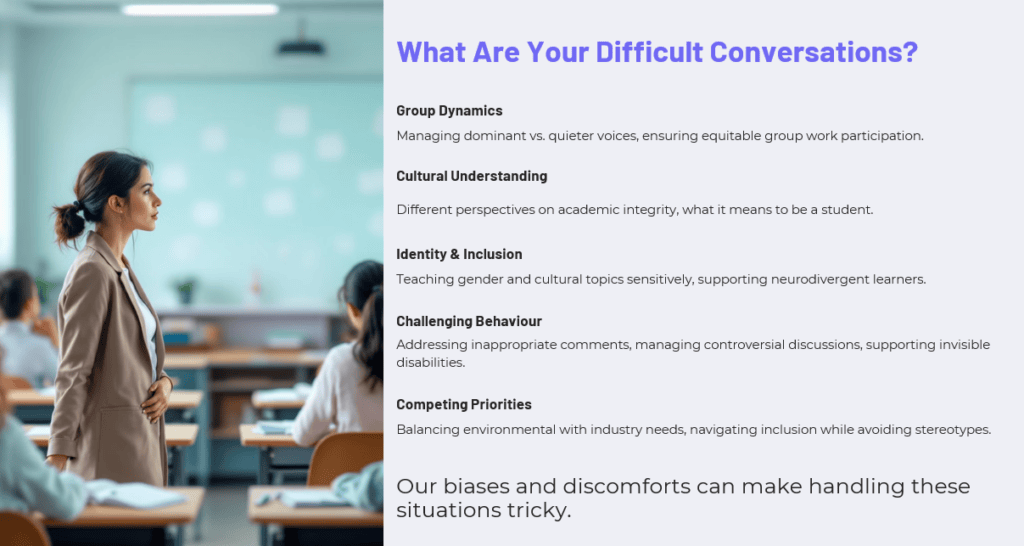In higher education, one of our most important goals is to help students develop the ability to think critically, question assumptions, and engage thoughtfully with complexity. Sometimes, that means wading into difficult conversations – those that challenge beliefs, explore sensitive topics, or provoke strong emotions. While these conversations can feel uncomfortable, they are often necessary for intellectual growth, empathy, and the development of real-world skills like negotiation and collaboration.
The tips below are taken from our Difficult Conversations workshop to support you for controversial or emotionally charged issues in your classrooms, and prepare students to engage with them constructively.
Published on: 23/04/2025 · Last updated on: 23/04/2025
What are Difficult Conversations?
Difficult conversations are topics that may be controversial or sensitive. They may challenge strong held beliefs or trigger a traumatic response. These conversations may come up unexpected or they may be planned. Sometimes the content and/or discussions are a necessary or vital learning and teaching moment for successful completion of a unit of study.

Before the Conversation: Laying the Groundwork
1. Cultivate Cultural Competence
Understanding who is in your classroom is a vital first step. The University Baseline Population Reports can help identify patterns across cohorts. These insights can inform more inclusive teaching strategies and help anticipate potential areas of misunderstanding.
Don’t forget to consider values, worldviews, and educational backgrounds. Ask yourself:
- Who is represented in your curriculum?
- Who might feel excluded?
- How do different cultural norms shape student expectations? How do they shape your expectations?
“A necessary precursor to working through ways to address the challenges arising from an increasingly diversified student cohort is an examination of the underlying attitudes, values, and systems that may give rise to difficulties for both staff and students.” – Ryan (2011)
2. Reflection
Before diving into difficult topics, reflect on your own experiences. When was a belief of yours challenged or changed? What prompted that shift? This type of reflective exercise fosters empathy – a critical trait for guiding others through complex discussions.
3. Prepare Students
Students benefit from preparation to participate in difficult discussions in ways that are meaningful and respectful. The more scaffolding we provide, the more confident and skilled students become at navigating sensitive topics. Here’s how to build that foundation:
During the Conversation: Navigating the Moment
When sensitive discussions begin, your role as facilitator becomes especially important. Techniques like the PAUSE method can help you slow the moment, acknowledge emotion, and redirect constructively.

It’s also vital to:
- Ask clarifying questions to uncover intent.
- Allow students the space to opt out if needed.
- Encourage listening, not just responding.
This is not about “winning” a debate—it’s about learning from each other.
After the Conversation: Reflection and Support
Once the moment has passed, the learning continues. Follow-up can include:
- Debriefs with the class, highlighting key takeaways and acknowledging discomfort.
- Individual check-ins with students who may have been affected.
- Reflection questions for yourself: What worked? What didn’t? What would I do differently next time?
This is a great opportunity to grow—not just as an educator, but as a co-learner in a shared space.
Support Services for Staff
- Support running workshops for students – “Controversy with Civility”, “Inclusive Communication” and other training aimed at students
- Training on student wellbeing and support process available to students – Staff Pastoral Support Training
- Guidance on supporting students – Student Support advice for staff
- Advice on how to respond to students in distress – Supporting Students in Distress
- Personal and Professional support for staff – Health Assured: Wellbeing Support
- Support for staff – Staff wellbeing
- Inclusive Learning & Teaching resources
- Article: Managing difficult conversations in the classroom
Support Services to Signpost for Students
- #NeverOk – Support and Report
- Support for students – Be Well – Talk Now
- Disability Support – Disability Service (bath.ac.uk)
- Security services – Security (bath.ac.uk)
- Consider providing relevant support information to students before / during / after discussion:
- SU Student groups – Race Equality Group, Disability Action Group (DAG), LGBT+, Mature Students Group, Student Parents Group
- The Interfaith Community can offer support for students from a wide range of faith communities
Conclusion
Facilitating difficult conversations is about preparing ourselves and our students to engage with complexity in a respectful, thoughtful way. With the right structures, reflection, and support, we can turn these challenging moments into powerful opportunities for growth, understanding, and genuine learning.
If you’d like to explore these approaches further or arrange a tailored workshop for your team, please get in touch with Lynn Cheong-White. I’d be happy to work with departments to build confidence around navigating sensitive or controversial topics in an inclusive and supportive way.